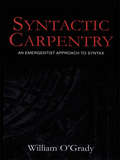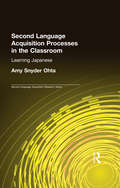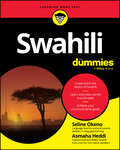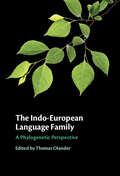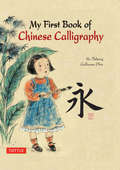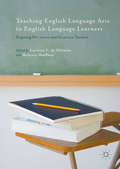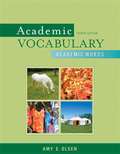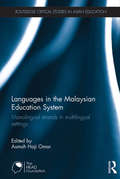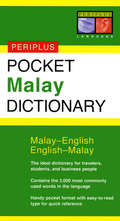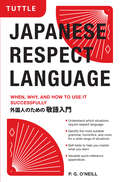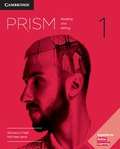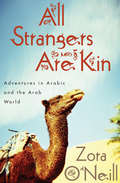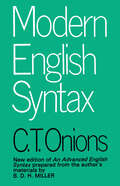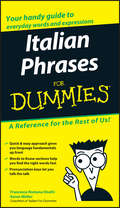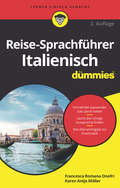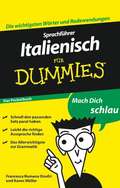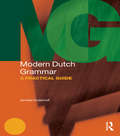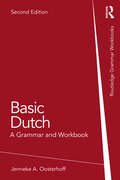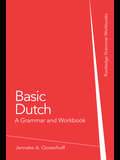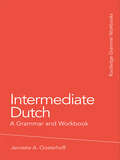- Table View
- List View
Syntactic Carpentry: An Emergentist Approach to Syntax
by William O'GradySyntactic Carpentry: An Emergentist Approach to Syntax presents a groundbreaking approach to the study of sentence formation. Building on the emergentist thesis that the structure and use of language is shaped by more basic, non-linguistic forces—rather than by an innate Universal Grammar—William O'Grady shows how the defining properties of various core syntactic phenomena (phrase structure, co-reference, control, agreement, contraction, and extraction) follow from the operation of a linear, efficiency-driven processor. This in turn leads to a compelling new view of sentence formation that subsumes syntactic theory into the theory of sentence processing, eliminating grammar in the traditional sense from the study of the language faculty. With this text, O'Grady advances a growing body of literature on emergentist approaches to language, and situates this work in a broader picture that also includes attention to key issues in the study of language acquisition, psycholinguistics, and agrammaticism. This book constitutes essential reading for anyone interested in syntax and its place in the larger enterprise of cognitive science.
Thanking and Politeness in Japanese
by Jun OhashiThis book synthesizes previous work on thanking, politeness and Japanese pragmatics and crystallises the theoretical underpinnings of thanking, how it is realized linguistically and the social meaning and significance of this aspect of Japanese communication.
Second Language Acquisition Processes in the Classroom: Learning Japanese (Second Language Acquisition Research Series)
by Amy Snyder OhtaThis book is the first study to examine how interactional style develops within the walls of a foreign language classroom in the first two years of language study. Results show learners to be highly sensitive to pragmatic information and that learners can move toward an appropriate interactional style through classroom interactive experience. The book shows how learners are most often sources who offer assistance and correction, with errors serving most often to stimulate further thinking about what form is correct. Analysis shows learners to be active in seeking corrective information in the classroom setting, not only from peer partners but also from the teacher. They are active in noticing how the teacher's utterances--even when addressed to others--contrast with their own, and utilize corrective feedback intended for other students. In addition, the results show that teacher-initiated corrective feedback addressed to individual learners is only one source of corrective feedback. Learners are shown to be active in both teacher-fronted and peer interactive settings. In newer L2 teaching methodologies which focus on the use of peer interactive tasks, the teacher's role has been de-emphasized. This book, however, shows how important the teacher's role is. The final chapter examines how the teacher can act to maximize the benefits of peer interactive tasks through how they design tasks and present them to the class. First, the chapter looks at how learners use English--their L1--in the classroom, concluding that how teachers present activities to the class has an impact on the amount of L1 used by students during peer interaction. Following up on this finding, the chapter works to address questions that teachers face in lesson planning and teaching. It presents a useful list of questions teachers can ask when designing peer interactive tasks in order to maximize the effectiveness of a wide variety of language learning tasks.
The Social Life of the Japanese Language
by Okamoto, Shigeko and Shibamoto-Smith, Janet S. Shigeko Okamoto Shibamoto-Smith, Janet S.Why are different varieties of the Japanese language used differently in social interaction, and how are they perceived? How do honorifics operate to express diverse affective stances, such as politeness? Why have issues of gendered speech been so central in public discourse, and how are they reflected and refracted in language use as social practice? This book examines Japanese sociolinguistic phenomena from a fascinating new perspective, focusing on the historical construction of language norms and its relationship to actual language use in contemporary Japan. This socio-historically sensitive account stresses the different choices which have shaped Japanese and Western sociolinguistics and how varieties of Japanese, honorifics and politeness, and gendered language have emerged in response to the socio-political landscape in which a modernizing Japan found itself.
Swahili For Dummies
by Seline Okeno Asmaha HeddiLearn the official language of Kenya and Tanzania Swahili For Dummies will teach you the basics of Swahili, so you can start conversing in Africa’s language of commerce. This book introduces you to the foundations of Swahili grammar and enables you to engage in basic conversations. With the simplified Dummies learning process, you’ll quickly get a grasp on the language, without complex terms and confusing explanations. You’ll also move through the book at a comfortable pace, so you’ll be familiar with what you’ve learned before moving on to more complex stuff. Focus on communication and interaction in everyday situations, so you can actually use the language you’re studying—right away. Understand the basics of Swahili Learn everyday words and phrases Gain the confidence to engage in conversations in Swahili Communicate while traveling and talk to Swahili-speaking family members Swahili For Dummies is for readers of all ages who want to learn the basics of Swahili in a no-stress, beginner-friendly way. Swahili teachers will also love sharing this practical approach with their students.
The Indo-European Language Family: A Phylogenetic Perspective
by Thomas OlanderModern languages like English, Spanish, Russian and Hindi as well as ancient languages like Greek, Latin and Sanskrit all belong to the Indo-European language family, which means that they all descend from a common ancestor. But how, more precisely, are the Indo-European languages related to each other? This book brings together pioneering research from a team of international scholars to address this fundamental question. It provides an introduction to linguistic subgrouping as well as offering comprehensive, systematic and up-to-date analyses of the ten main branches of the Indo-European language family: Anatolian, Tocharian, Italic, Celtic, Germanic, Greek, Armenian, Albanian, Indo-Iranian and Balto-Slavic. By highlighting that these branches are saliently different from each other, yet at the same time display striking similarities, the book demonstrates the early diversification of the Indo-European language family, spoken today by half the world's population. This title is also available as open access on Cambridge Core.
My First Book of Chinese Calligraphy
by Guillaume Olive Zhihong HeMy First Book of Chinese Calligraphy is a fun and engaging introduction to one of China's most popular arts and crafts for kids. <P><P>Calligraphy-the art of producing decorative handwriting or lettering with a pen or brush-has been around for thousands of years. In this book, readers will follow along with Mimi who takes her first steps towards learning this magical art. Dive in, and explore:The Evolution of Chinese Writing-how Chinese characters first began, thousands of years ago, and how they have evolvedThe Order of the Strokes-learn how to write the strokes in the correct orderThe Four Treasures of Calligraphy- the four essential tools to get startedMovements and Position-how to master your mind's focus, your breathing and even how to moveThe Five Styles of Calligraphy-Zhuan Shu (seal), Li Shu (clerical), Kai Shu (regular), Cao Shu (cursive), and Xing Shu (running)The Eight Strokes- how to draw the 8 strokes; with them, you can write anythingWriting a Character in Calligraphy-create an entire character in calligraphyThe included interactive CD-ROM enables learners to play creative games to see, hear and try Chinese writing; listen to the pronunciation of the Chinese characters; observe calligraphers in action and print the characters to create practice pages.
Teaching English Language Arts to English Language Learners
by Luciana C. Oliveira Melanie ShoffnerThis book focuses on the ways in which English language arts (ELA) pre-service and in-service teachers have developed - or may develop - instructional effectiveness for working with English language learners (ELL) in the secondary English classroom. Chapter topics are grounded in both research and practice, addressing a range of timely topics including the current state of ELL education in the ELA classroom, and approaches to leveraging the talents and strengths of bilingual students in heterogeneous classrooms. Chapters also offer advice on best practices in teaching ELA to multilingual students and ways to infuse the secondary English teacher preparation curriculum with ELL pedagogy. Comprehensive in scope and content and examining topics relevant to all teachers of ELLs, teacher educators and researchers, this book appeals to an audience beyond ELA teachers and teacher educators.
Academic Vocabulary, Academic Words (4th edition)
by Amy E. OlsenAcademic Vocabulary presents vocabulary building with a visually stimulating, full-color design to pique students' interest and make the process fun. This attractive, highly-interactive workbook improves academic word knowledge through academic readings and interactive exercises. Repetition of the words and getting the students to see the words used in multiple contexts improves memorization.
Languages in the Malaysian Education System: Monolingual strands in multilingual settings (Routledge Critical Studies in Asian Education)
by Asmah Haji OmarThis book provides an overview of language education in Malaysia, covering topics such as the evolution of the education system from pre-independence days to the present time, to the typology of schools, and the public philosophy behind every policy made in the teaching of languages. The book consists of chapters devoted to the teaching of languages that form separate strands but are at the same time connected to each other within the education system. These chapters discuss: Implementing the national language policy in education institutions English in language education policies and planning in Malaysia Chinese and Tamil language education in Malaysia Teaching of indigenous Malaysian languages The role of translation in education in Malaysia It also discusses the development of language which enables the national language, Malay, to fulfil its role as the main medium of education up to the tertiary level. This book will be of interest to researchers studying language planning, teacher education and the sociology of education, particularly, within the Malaysian context.
Pocket Malay Dictionary
by Zuraidah OmarThis is a pocket sized Malay DictionaryIntended for use by tourists, students, and business people traveling to Malaysia Pocket Malay Dictionary is an essential tool for communicating in Malay. It features all the essential Malay vocabulary appropriate for beginning to intermediate students. It's handy pocket format and easy-to read type will make any future trip to Malaysia much easier. In addition to being an excellent English to Malay dictionary and Malay to English dictionary Pocket Malay Dictionary contains important notes on the Malay language, Malay grammar and Malay pronunciation. All Malay words are written in English and Malay script (Rumi) so that in the case of difficulties the book can simply be shown to the person the user is trying to communicate with.This dictionary contains:The 3,000 most commonly used words in the Malay languageEnglish and Romanized Malay (Rumi)An introduction to and history of the Malay languageInformation on Malay grammarA guide to pronouncing Malay correctlyOther books from this bestselling series you might enjoy are: Pocket Vietnamese Dictionary, Pocket Cambodian Dictionary, Pocket Thai Dictionary, Pocket Indonesian Dictionary, Pocket Mandarin Chinese Dictionary, and Pocket Cantonese Dictionary.
Pocket Malay Dictionary
by Zuraidah OmarThis is a pocket sized Malay DictionaryIntended for use by tourists, students, and business people traveling to Malaysia Pocket Malay Dictionary is an essential tool for communicating in Malay. It features all the essential Malay vocabulary appropriate for beginning to intermediate students. It's handy pocket format and easy-to read type will make any future trip to Malaysia much easier. In addition to being an excellent English to Malay dictionary and Malay to English dictionary Pocket Malay Dictionary contains important notes on the Malay language, Malay grammar and Malay pronunciation. All Malay words are written in English and Malay script (Rumi) so that in the case of difficulties the book can simply be shown to the person the user is trying to communicate with.This dictionary contains:The 3,000 most commonly used words in the Malay languageEnglish and Romanized Malay (Rumi)An introduction to and history of the Malay languageInformation on Malay grammarA guide to pronouncing Malay correctlyOther books from this bestselling series you might enjoy are: Pocket Vietnamese Dictionary, Pocket Cambodian Dictionary, Pocket Thai Dictionary, Pocket Indonesian Dictionary, Pocket Mandarin Chinese Dictionary, and Pocket Cantonese Dictionary.
Pocket Malay Dictionary
by Zuraidah OmarThis is a pocket sized Malay DictionaryIntended for use by tourists, students, and business people traveling to Malaysia Pocket Malay Dictionary is an essential tool for communicating in Malay. It features all the essential Malay vocabulary appropriate for beginning to intermediate students. It's handy pocket format and easy-to read type will make any future trip to Malaysia much easier. In addition to being an excellent English to Malay dictionary and Malay to English dictionary Pocket Malay Dictionary contains important notes on the Malay language, Malay grammar and Malay pronunciation. All Malay words are written in English and Malay script (Rumi) so that in the case of difficulties the book can simply be shown to the person the user is trying to communicate with.This dictionary contains:The 3,000 most commonly used words in the Malay languageEnglish and Romanized Malay (Rumi)An introduction to and history of the Malay languageInformation on Malay grammarA guide to pronouncing Malay correctlyOther books from this bestselling series you might enjoy are: Pocket Vietnamese Dictionary, Pocket Cambodian Dictionary, Pocket Thai Dictionary, Pocket Indonesian Dictionary, Pocket Mandarin Chinese Dictionary, and Pocket Cantonese Dictionary.
Japanese Respect Language: When, Why, and How to use it Successfully
by P. G. O'NeillRespect language—the special style of polite spoken or written Japanese—is involved almost every exchange of Japanese between one person and another, including the simplest phrases of greeting.<P><P> An understanding of its forms is therefore essential to any serious student of the Japanese language. This programmed course is carefully designed to teach the basic and correct forms which the learner should master for his or her own use, by first looking at the various typical situations to see when respect should and should not be shown in Japanese, and then going on to see how respect is expressed in special forms of speech. In this way the learner is shown how to identify the type of respect for used, the person to whom respect is being shown, and the equivalent form in colloquial language. The insights into both Japanese culture and language will help any student or businessperson traveling to Japan or speaking Japanese on a regular basis.
Prism: Level 1 Student's Book With Online Workbook Reading And Writing (Prism)
by Richard O'Neill Michele Lewis Wendy Asplin Carolyn FloresPrism Level 1 Student's Book Reading and Writing 9
All Strangers Are Kin: Adventures in Arabic and the Arab World
by Zora O'Neill"The shaddais the key difference between a pigeon (hamam) and a bathroom (hammam). Be careful, our professor advised, in the first moment of outright humor in class, that you don't ask a waiter, 'Excuse me, where is the pigeon?' -- or, conversely, order a roasted toilet." If you've ever studied a foreign language, you know what happens when you first truly and clearly communicate with another person. As Zora O'Neill recalls, you feel like a magician. If that foreign language is Arabic, you just might feel like a wizard. They say that Arabic takes seven years to learn and a lifetime to master. O'Neill had put in her time. Steeped in grammar tomes and outdated textbooks, she faced an increasing certainty that she was not only failing to master Arabic, but also driving herself crazy. She took a decade-long hiatus, but couldn't shake her fascination with the language or the cultures it had opened up to her. So she decided to jump back in--this time with a new approach. Join O'Neill for a grand tour through the Middle East. You will laugh with her in Egypt, delight in the stories she passes on from the United Arab Emirates, and find yourself transformed by her experiences in Lebanon and Morocco. She's packed her dictionaries, her unsinkable sense of humor, and her talent for making fast friends of strangers. From quiet, bougainvillea-lined streets to the lively buzz of crowded medinas, from families' homes to local hotspots, she brings a part of the world that is thousands of miles away right to your door. A natural storyteller with an eye for the deeply absurd and the deeply human, O'Neill explores the indelible links between culture and communication. A powerful testament to the dynamism of language, All Strangers Are Kin reminds us that learning another tongue leaves you rich with so much more than words.
Interaction: Langue Et Culture
by Susan St. Onge Ronald St. OngeINTERACTION: LANGUE ET CULTURE, 8th Edition is a complete intermediate French program offering unparalleled support for the study of culture, literature, and language. This successful program contains a broad range of cultural and literary content and concise, yet thorough, grammar explanations in a convenient, one-book format. The Eighth Edition is accompanied by a technologically enhanced multimedia package, including a video program and iLrn " : Heinle Learning Center--a powerful, all-in-one online solution that helps you get the most out of your course.
Modern English Syntax
by C.T. OnionsThis standard introductory textbook presents in systematic form an account of current English practice. The introduction provides a full scheme of sentence analysis. Part I contains a treatment of syntactical phenomena based on the analysis of sentences; Part II classifies the uses of forms. Cross-references indicate how the two parts supplement one another.
Italian Phrases For Dummies
by Francesca Romana Onofri Karen Antje MöllerEveryday conversations in Italian made easy Italy is a perennially popular destination for Americans, with three cities (Florence, Rome, and Venice) among the top ten in Travel & Leisure's 2003 "World's Best Cities" poll. This concise, easy-to-use guide helps travelers and students get up to speed fast on conversational Italian, showcasing the most commonly used words and phrases. Francesca Romana Onofri is an Italian translator and teacher. Karen Moller is a writer who has worked on several Italian-language projects for Berlitz.
Reise-Sprachführer Italienisch für Dummies (Für Dummies)
by Francesca Romana Onofri Karen Antje MöllerDer "Reise-Sprachführer Italienisch für Dummies" bietet einen schnellen Überblick über die wichtigsten Wörter und Redewendungen für den Reise-Alltag. Jedes Kapitel beschäftigt sich mit einer typischen Situation. So haben Sie schnell die passenden Sätze parat, wenn Sie sich beispielsweise jemandem vorstellen, im Restaurant bestellen oder nach einer Wegbeschreibung fragen. Dazu bekommen Sie eine kurze Einführung in die Grammatik und Aussprache des Italienischen.
Sprachführer Italienisch für Dummies Das Pocketbuch (Für Dummies)
by Francesca Romana Onofri Karen Antje Möller"Sprachführer Italienisch für Dummies" bietet einen schnellen Überblick über die wichtigsten Wörter und Redewendungen für den Alltag. Jedes Kapitel beschäftigt sich mit einer Alltagssituation. So haben Sie schnell die passenden Sätze parat, wenn Sie sich beispielsweise jemandem vorstellen, im Restaurant bestellen oder nach einer Wegbeschreibung fragen. Dazu bekommen Sie eine kurze Einführung in die Grammatik und Aussprache des Italienischen.
Modern Dutch Grammar: A Practical Guide (Modern Grammars)
by Jenneke OosterhoffModern Dutch Grammar: A Practical Guide is an innovative reference guide to Dutch, combining traditional and function-based grammar in a single volume. With a strong emphasis on contemporary usage, all grammar points and functions are richly illustrated with examples. The Grammar is divided into two parts. Part I covers traditional grammatical categories such as nouns and verbs. Part II is carefully organized around language functions and contexts such as: Giving and seeking information Describing processes and results Expressing attitudes, mental states and emotions Registers and style Formal and informal communication, e.g. youth talk Main features of the Grammar include: Clear, succinct and jargon-free explanations Extensive cross-referencing between the different sections Emphasis on areas of particular difficulty for learners of Dutch This is the ideal reference grammar for learners of Dutch at all levels, from elementary to advanced; no prior knowledge of grammatical terminology is assumed and it provides indices of grammatical terms and functions. This Grammar is complemented by a companion website featuring related exercises and activities to reinforce learning.
Basic Dutch: A Grammar and Workbook (Routledge Grammar Workbooks)
by Jenneke A. OosterhoffBasic Dutch: A Grammar and Workbook comprises an accessible reference grammar and related exercises in a single volume. This second edition contains new chapters on spelling, pronunciation, and indirect speech, as well as revised and additional exercises with lists of new vocabulary.This comprehensive book presents 31 individual grammar points in realistic contexts, taking a grammatical approach that allows students not already familiar with these structures to become accustomed to their use. Grammar points are followed by examples and exercises, allowing students to reinforce and consolidate their learning. Key features include: a full answer key grammar tables for easy reference frequent comparative references to English grammar appendices of pronunciation, pronouns, and strong verbs a list of new vocabulary at the end of each chapter Suitable for class use or self-study, Basic Dutch is the ideal companion for students in their first year of study, providing the basic tools needed to communicate in a variety of situations and an introduction to Dutch culture.
Basic Dutch: A Grammar and Workbook (Grammar Workbooks)
by Jenneke A. OosterhoffBasic Dutch: A Grammar and Workbook comprises an accessible reference grammar and related exercises in a single volume. This Workbook presents twenty-five individual grammar points in realistic contexts, providing a grammatical approach which will allow students not already familiar with these structures to become accustomed to their use. Grammar points are followed by examples and exercises allowing students to reinforce and consolidate their learning. Suitable for class use or self-study, Basic Dutch introduces Dutch culture and people through the medium of the language used today, providing students with the basic tools to express themselves in a wide variety of situations. Features include: useful exercises and a full answer key grammar tables for easy reference frequent comparative references to English grammar an appendix of irregular verbs an index of grammatical terms.
Intermediate Dutch: A Grammar and Workbook (Grammar Workbooks)
by Jenneke A. OosterhoffIntermediate Dutch is designed for learners who have achieved a basic proficiency and wish to refine their knowledge of grammatical structures. This Workbook, along with its companion volume Basic Dutch, provides clear and concise summaries of the essential points of Dutch grammar as well as opportunities to practice using the structures of the language. Building on the lessons of Basic Dutch, each of the twenty-four units presents a grammatical topic with an introduction and overview, followed by contextualized exercises to reinforce learning. Features include: a clear accessible format many useful language examples abundant exercises with a full answer key frequent references to English grammar an appendix on irregular verbs an index of grammatical keywords. Suitable for independent learners and students on taught courses, Intermediate Dutch, together with its sister volume Basic Dutch, forms a structured course in the essentials of Dutch grammar.
